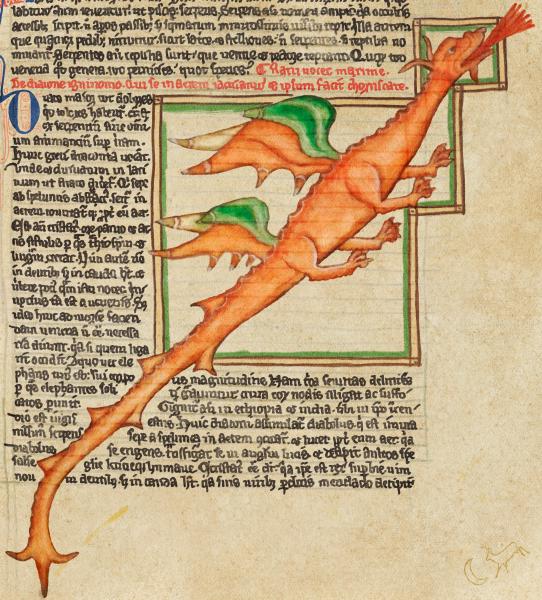I now believe it to be the tedium of constructing the history lesson portion of the essay that has led to my employing my README tone in order to maintain my interest. I'm now seven dragons deep … but who knows what I'll end up keeping once I've muddled through the remaining ten dragons (and the ten other assets that follow). Right now, it's all:
On Dragon Weaving
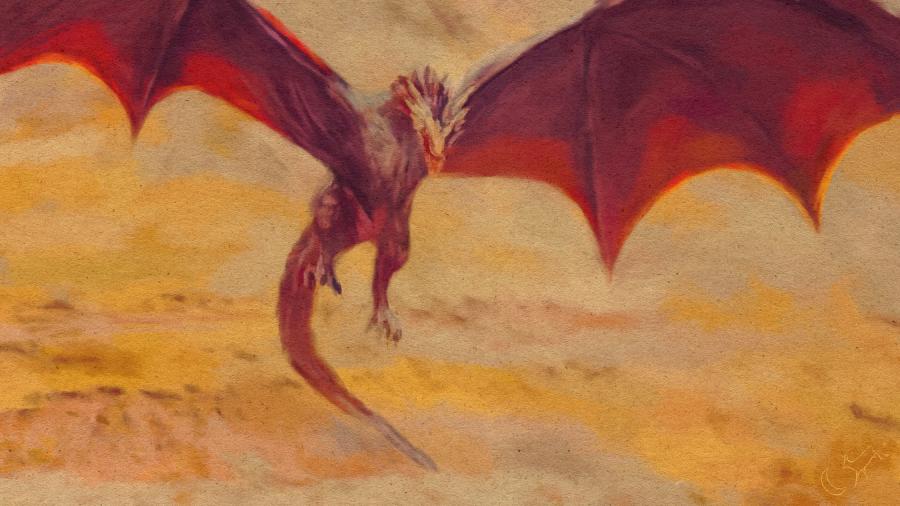
Honesty, I haven't a clue why, in February of last year, I found myself pondering the web of dragon mythology that so ensnares the imagination of man. Of how the machinations of my mind materialized the path it would then travel, I've an even clumsier grasp. I believe there is something significant to be found within the folds of fumbled expression held by the essay I had composed. Now, a year later (finding myself in possession of more diversely and formidably equipped faculties), I shall recompose its art and prose, hoping to attain a composition that more capably communicates that which I have to say. It shall be begin with a declaration.
I find them fascinating, the common threads with which disconnected hubs of humanity weave their native narratives. The similitude with which humanity engineers itself by independent means astounds. It warrants remark, in this digitally polarized age of humanity where tribal gutturals dissemble themselves as discourse, the resemblance that runs through the clutch of reflections caught by the collective looking glass.
Such abstraction, dear reader, may satisfy my selfish need to soliloquize; however, it achieves very little in the way of conceptual connection. We need something concrete, an example exhibiting qualities consistent with the previous prose. What though? Which player shall I pluck from the troupe?
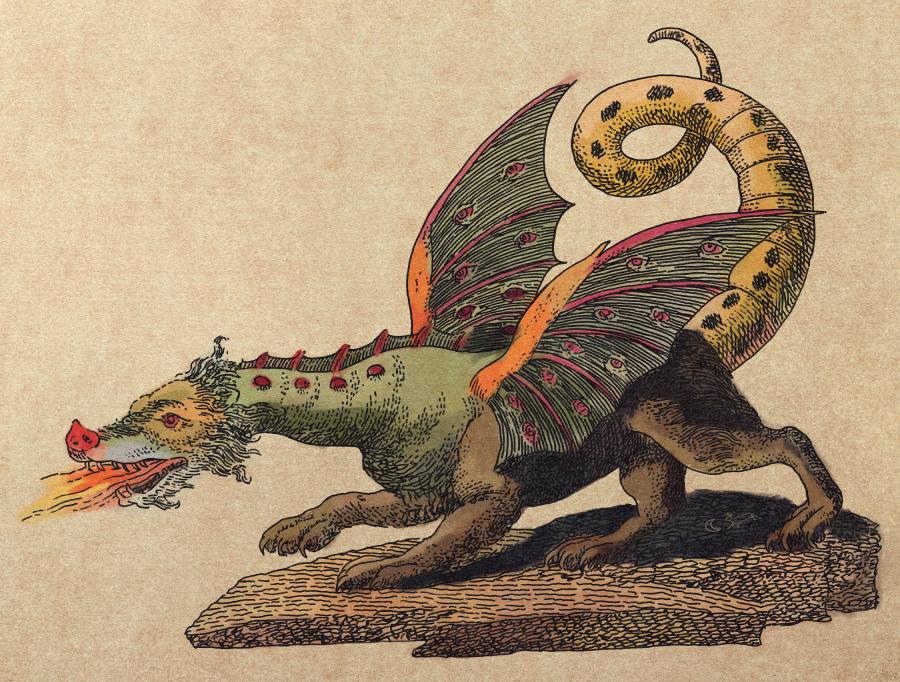
Of course it's f$&kin' dragons. I named this f$&kin' thing On Dragon Weaving, how the f$&k would I ever work this f$&ker into an essay befitting of the name were I not, inevitably, about to begin talking about dragons? I mean … I name dropped the little f$&kers in what I believe we've settled upon calling this essay's preamble. Let's hop f$&kin' to it, shall we?
Right. Dropping ourselves down deeply within the well of humanity to probe Terrestrian time before the Biblical flood, we'll begin with Apep (pronounced 𓌇𓊪𓊪𓆙) in Ancient Egypt.
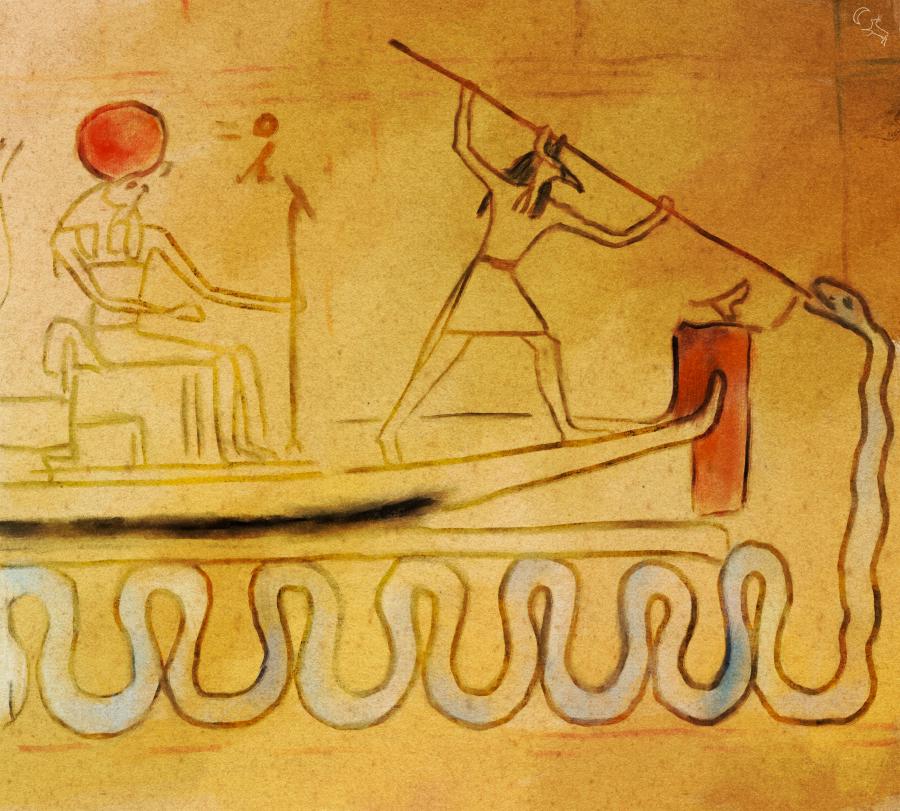
Mention of this particular deity began appearing early in the 22nd century BC as the sun was setting upon the authority of the Old Kingdom. As chaos incarnate, oppugnant to order and light, no doubt Apep was frequently sighted walking in Memphis near the collapse of the Eighth Dynasty. And get this, when Isis, Set, and Ra jacked Apep (as part of their Egyptian power grab), tossing him into the underworld … Apep was having none of it. Every morning thereafter he'd make his way back to the horizon, ahead of Ra, and force that f$&ker to defeat him in battle just to put the sun in the sky. And in the event of a solar eclipse … an eclipse meant that Apep managed to swallow that f$&ker … the sun returning to the sky only after Ra's companion gods manage to topple Apep and cut open his stomach.
Before we exoduse ourselves out of Egypt, we simply must allow ourselves a proper peep at the world's most interminable orbiculate ophidian, Ouroboros.
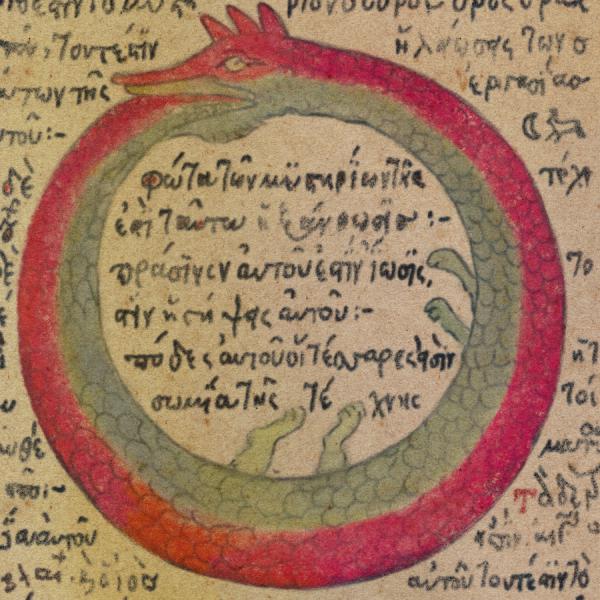
A manifestation of the snake god Mehen, Ouroboros may be found inscribed upon the shrine of a sarcophagus as part of the Enigmatic Book of the Netherworld where he represents the beginning and the end of time.
Drawings of Ouroboros would later begin popping up in early alchemical texts like that of Cleopatra the Alchemist, whose work The Chrysopoeia of Cleopatra contains an illustration (not pictured) of the serpent along with the words ἓν τὸ πᾶν (the all is one). The inside of my left leg happens to have this very same illustration (also not pictured) just above the ankle. Telling you that last bit serves zero f$&kin' purpose, so let me tell you at least one more interesting bit about Boros before we move along to our next exhibit.
Chuck yourself a dart at any wall-hung world map and chances are you'll strike land where Ouroboros dwells. In Norse mythology, exempli gratia (the WordHippoist's for example), he appears as Jörmungandr, the World Serpent–who would grow so large he could encircle the world, grasping his tail in his teeth. Come Ragnarok, it is the poisonous breath of the Midgard Wyrm that kills the mighty Thor.
Germanic myth, Norse inclusive, is simply dripping with dragons. Just look at the Vikings … I mean … they sailed f$&king drakkar.
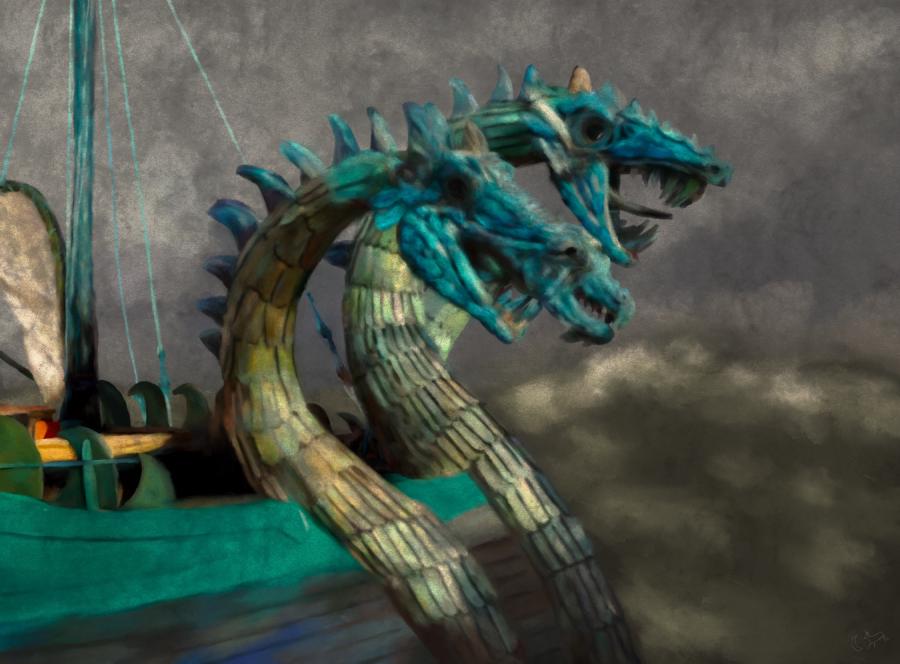
The dragonhead(s) carved into the stem of these large longships were said to offer protection from evil spirits while at sea. Such power did these wooden drakes possess that Icelandic code of the time, Grágás, bade the Vikings remove any such dragonhead upon their return so as not to intimidate the spirits of their native land.
The three carved heads on the ship above identify the bow-based bulwark as a dragon named Zmey Gorynych, let's gallantly gallivant into Garðaríki for a formal introduction.

Garðaríki, by the way, is Old Norse for Kievan Rus'. The Garðar were the Rus' people, Norsemen that had decided to pop on over and take up ruling the river routes between the Baltic and the Black Seas. You zmey have deduced from all those f$&king letter 'Y's, we've crossed over the Germanian border into Russian folklore territory.
Zmey was all about the bylina (Russian heroic poetry). Totally tracks that he would frequently transform himself into a handsome youth to engage in the art of seduction.
Don't let his pervish proclivities prevaricate (yeeesss … I f$&king see the problem … but WordHippo sticks that sh$t in my head … and I can avoid alliteration like Murphy can avoid running head first into a thumpish engagment with the thick, full-length windows that monopolize wall space around here when she's so f$&king excited she can take no more).
Zmey is a proper red-scaled, fire-breathing western dragon with blood so poisonous the Earth itself will refuse to absorb it. This little f$&ker would even go all eclipsical from time to time by taking a bite out of the f$&king sun.
A dark age concoction, the western dragon is typically depicted as large, fire-breathing, scaly, horned, four-legged, bat-winged and in possession of a long, muscular prehensile tail handy for curling up cozily inside its underground lair. Between the eleventh and thirteenth centuries, that dragons were living, fire-breathing creatures was common f$&kin' knowledge.
The first known portrayal a western dragon appears in a medieval manuscript circa 1260ish.
